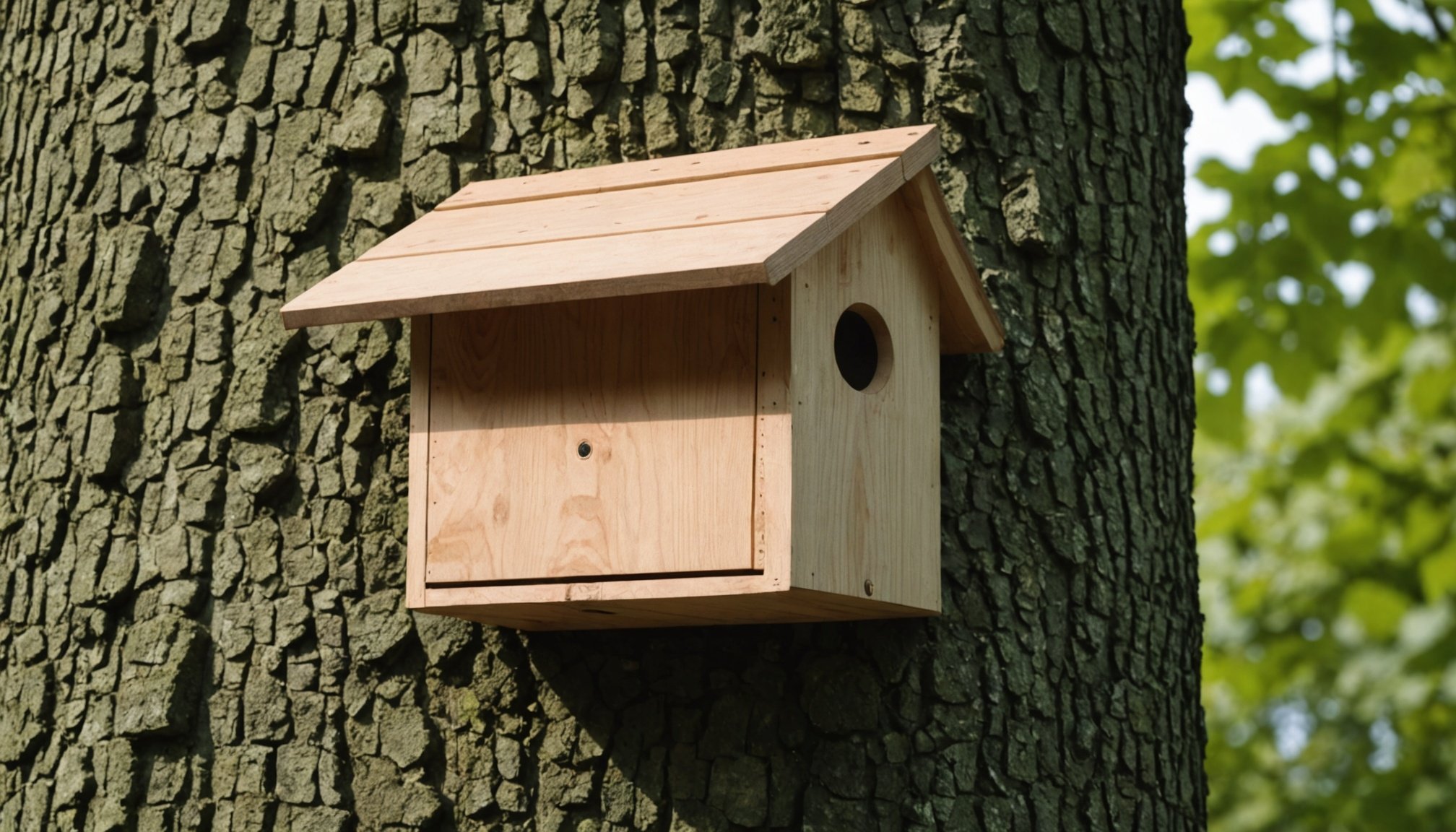Crafting the Perfect Bat Boxes for Your Local Environment: An Ultimate Guide for UK Homeowners
Understanding the Importance of Bat Conservation
Before we dive into the nitty-gritty of designing and building bat boxes, it’s essential to understand why these tiny creatures are so crucial to our ecosystem. Bats are vital components of our wildlife, playing a significant role in maintaining the balance of nature. They are primary predators of insects, helping to control pest populations that could otherwise damage crops and gardens.
“Bats rely on a diverse landscape that includes woodlands, hedgerows, and water bodies, which provide food and roosting sites,” explains a guide on bat conservation in rural UK[2]. By supporting bat populations, you are indirectly contributing to the health of your garden and the broader local biodiversity.
Also read : Preserving the past: a deep dive into the uk”s initiatives and strategies for protecting ancient trees
Assessing Your Local Environment
To create bat boxes that are tailored to your local environment, you need to understand the specific needs and preferences of the bat species in your area.
Identifying Local Bat Species
The UK is home to numerous bat species, each with distinct preferences for habitat. For instance, the common pipistrelle thrives in woodland edges and urban areas, while the rare grey long-eared bat favours meadows and grasslands[2].
In parallel : Ultimate guide for uk wildlife volunteers: mastering the rescue of birds affected by oil spills
Evaluating Habitat Requirements
Natural habitats play an essential role in preserving bat populations. Look for areas with a mix of natural resources such as trees, shrubs, and water bodies. These features serve as roosting and hunting grounds for bats.
- Water Sources: Bats often rely on water bodies not only for hydration but also as feeding grounds due to the abundance of insects.
- Vegetation: Diverse plant life contributes to a robust insect population, which is vital for a bat’s diet. Dense foliage also provides natural cover and protection from predators.
- Landscape Features: Natural barriers like hills or forests can offer weather protection, while open areas may increase exposure to predators and harsh elements[2].
Designing Bat-Friendly Boxes
The design of your bat box is crucial for its effectiveness. Here are some key considerations:
Materials and Construction
- Use Sustainable Materials: Opt for untreated and weather-resistant wood, such as cedar or plywood. These materials extend the durability of the boxes and are eco-friendly[2][5].
- Internal Cavity Design: Ensure the internal cavities are narrow yet spacious enough for bats to move comfortably. A typical bat box should have multiple compartments to mimic the conditions of natural roosting sites.
Placement and Orientation
- Height: Bat boxes should be positioned at least 12 to 20 feet above the ground to protect the bats from predators.
- Orientation: Ideally, bat boxes should face south or southeast to capture morning sunlight, which helps maintain an optimal temperature[2].
Key Features of a Bat Box
Here are some essential features to include in your bat box design:
Ventilation and Insulation
- Proper Ventilation: Ensure the box has adequate ventilation to maintain a healthy environment. This can be achieved through small gaps or vents.
- Insulation: Use natural insulation materials like wood shavings or sawdust to keep the box warm and cozy.
Entrance and Exit Points
- Narrow Entrance: The entrance should be narrow, typically around 2-3 cm wide, to mimic the natural roosting sites and protect the bats from predators.
Maintenance
- Annual Checks: Perform annual checks for wear and repairs if necessary to ensure the longevity and usability of the box.
Practical Tips for Installing Bat Boxes
Here are some practical tips to keep in mind when installing your bat boxes:
Choosing the Right Location
- Proximity to Water: Install the bat box near a water source, such as a river or pond, to enhance the opportunity for bats to engage in their natural behaviors[2].
- Sunlight Exposure: Ensure the box receives adequate sunlight, especially in the morning, to maintain a warm and inviting environment.
Avoiding Common Mistakes
- Avoid Using Chemicals: Refrain from using pesticides and herbicides in your garden, as these can harm bats by reducing their food sources[2].
- Low Maintenance: Opt for low-maintenance materials and designs to ensure the box remains in good condition over time.
Integrating Bat Boxes into Your Garden Design
Incorporating bat boxes into your garden design can enhance both the aesthetic appeal and the biodiversity of your outdoor space.
Combining with Other Wildlife Features
- Bird Boxes and Feeders: Consider combining bat boxes with bird boxes and feeders to create a comprehensive wildlife garden.
- Water Features: Adding water features like ponds or wetlands can attract insects, providing a feeding ground for bats and other wildlife[2].
Using Native Plants
- Native Plant Species: Plant native species in your garden, as these are more likely to attract local insect populations that bats feed on.
- Diverse Plant Life: Maintain a diverse range of plants to ensure a robust insect population throughout the year.
Legal and Regulatory Considerations
When undertaking any project that involves wildlife, it’s crucial to be aware of the legal and regulatory requirements.
Planning Permission and Surveys
- Bat Surveys: If you suspect bats are living in your loft or other parts of your home, you may need to conduct a bat survey before starting any construction work. This can cost between £300-£400[1].
- Mitigation Licences: If bats are found, you may need to obtain a mitigation licence to carry out the work, especially if the bats are a protected species[1][5].
Collaborative Approaches
- Early Collaboration: Success in managing bats during housing maintenance or self-build projects begins with early and close coordination between property owners, ecologists, and regulatory bodies[5].
Case Study: Sheffield City Council’s Initiative
The Sheffield City Council’s initiative provides a practical example of how to integrate bat conservation into large-scale housing maintenance projects.
Key Features
- Grouping Properties: Properties were grouped into zones for efficient survey efforts.
- Tiered Survey Methodology: A tiered survey methodology was employed, starting with transect walks and refining efforts based on findings.
- Bespoke Bat Access Tiles: Bat access tiles were installed on 25% of properties to ensure roosting access.
- Retaining Open Eaves: Open eaves were retained to ensure roosting access[5].
Lessons Learned and Recommendations
Here are some key lessons and recommendations from the Sheffield case study and other best practices:
Early Planning and Collaboration
- Collaborate Early: Engage with ecologists, local authorities, and contractors early in the project to create tailored solutions that balance conservation with development needs[5].
Adaptive Mitigation Strategies
- Adaptive Methods: Be prepared to adjust approaches as new information emerges during project implementation. This could include installing temporary woodcrete bat boxes as interim solutions[5].
Eco-Friendly Practices
- Avoid Chemicals: Opt for natural pest control methods and avoid chemical treatments to create a more sustainable environment beneficial to bats and other wildlife[2].
Crafting the perfect bat boxes for your local environment is a rewarding project that not only supports local biodiversity but also enhances the aesthetic appeal and ecological balance of your garden. By understanding the specific needs of local bat species, designing bat-friendly boxes, and integrating these into your garden design, you can create a welcoming space for these vital creatures.
Final Tips
- Monitor and Maintain: Regularly monitor and maintain your bat boxes to ensure they remain effective and safe for the bats.
- Educate and Engage: Educate your family and community about the importance of bat conservation and involve them in the process of creating a wildlife-friendly garden.
By following this ultimate guide, you can contribute to the conservation of bats and enrich your home and garden with the beauty and benefits of these fascinating creatures.
Detailed Checklist for Building a Bat Box
Here is a detailed checklist to help you build a bat box tailored to your local environment:
-
Materials:
-
Untreated and weather-resistant wood (e.g., cedar or plywood)
-
Wood shavings or sawdust for insulation
-
Nails or screws
-
Waterproof glue
-
Paint or varnish (optional)
-
Tools:
-
Saw
-
Drill
-
Hammer
-
Tape measure
-
Pencil and marker
-
Design Considerations:
-
Multiple compartments
-
Narrow entrance (2-3 cm wide)
-
Proper ventilation
-
Insulation
-
Durable and weather-resistant construction
-
Placement:
-
At least 12 to 20 feet above the ground
-
Facing south or southeast
-
Near a water source (if possible)
-
Maintenance:
-
Annual checks for wear and repairs
-
Avoid using chemicals in the surrounding area
Table: Comparison of Different Bat Box Designs
| Feature | Simple Bat Box | Advanced Bat Box | Composite Bat Box |
|---|---|---|---|
| Materials | Untreated wood | Weather-resistant wood | Composite materials |
| Compartments | Single compartment | Multiple compartments | Multiple compartments |
| Entrance | Wide entrance | Narrow entrance (2-3 cm) | Narrow entrance (2-3 cm) |
| Ventilation | Basic ventilation | Proper ventilation with vents | Advanced ventilation system |
| Insulation | Basic insulation | Wood shavings or sawdust | Advanced insulation materials |
| Placement | Any orientation | South or southeast facing | South or southeast facing |
| Maintenance | Low maintenance | Annual checks and repairs | Low maintenance |
Quotes and Insights
- “Bats are sensitive to disruptions in their environments caused by agricultural expansion and urban development. Effective bat conservation strategies require ensuring suitable habitats and minimising negative impacts from human activities.”[2]
- “The use of hessian-backed Type 1F felt, as highlighted in case studies, exemplifies simple yet effective mitigation measures that accommodate both bats and the logistical demands of the project.”[5]
- “By fostering collaboration, employing proportionate survey efforts, and implementing adaptive mitigation strategies, it is possible to safeguard bat populations while meeting housing needs.”[5]
By following this guide, you can create a bat-friendly environment in your garden that not only supports local wildlife but also enhances the beauty and biodiversity of your outdoor space. Happy gardening and bat-box building









